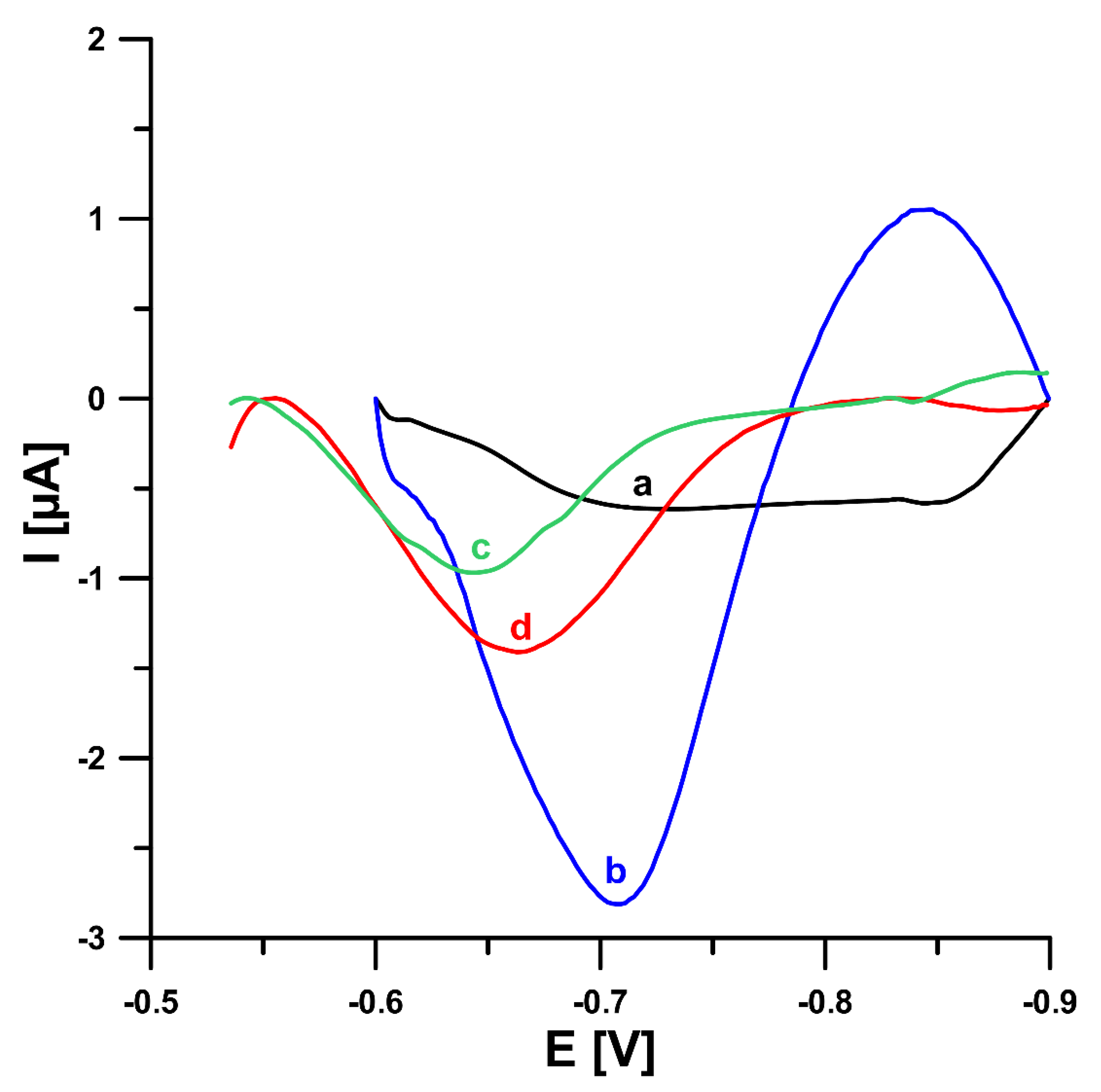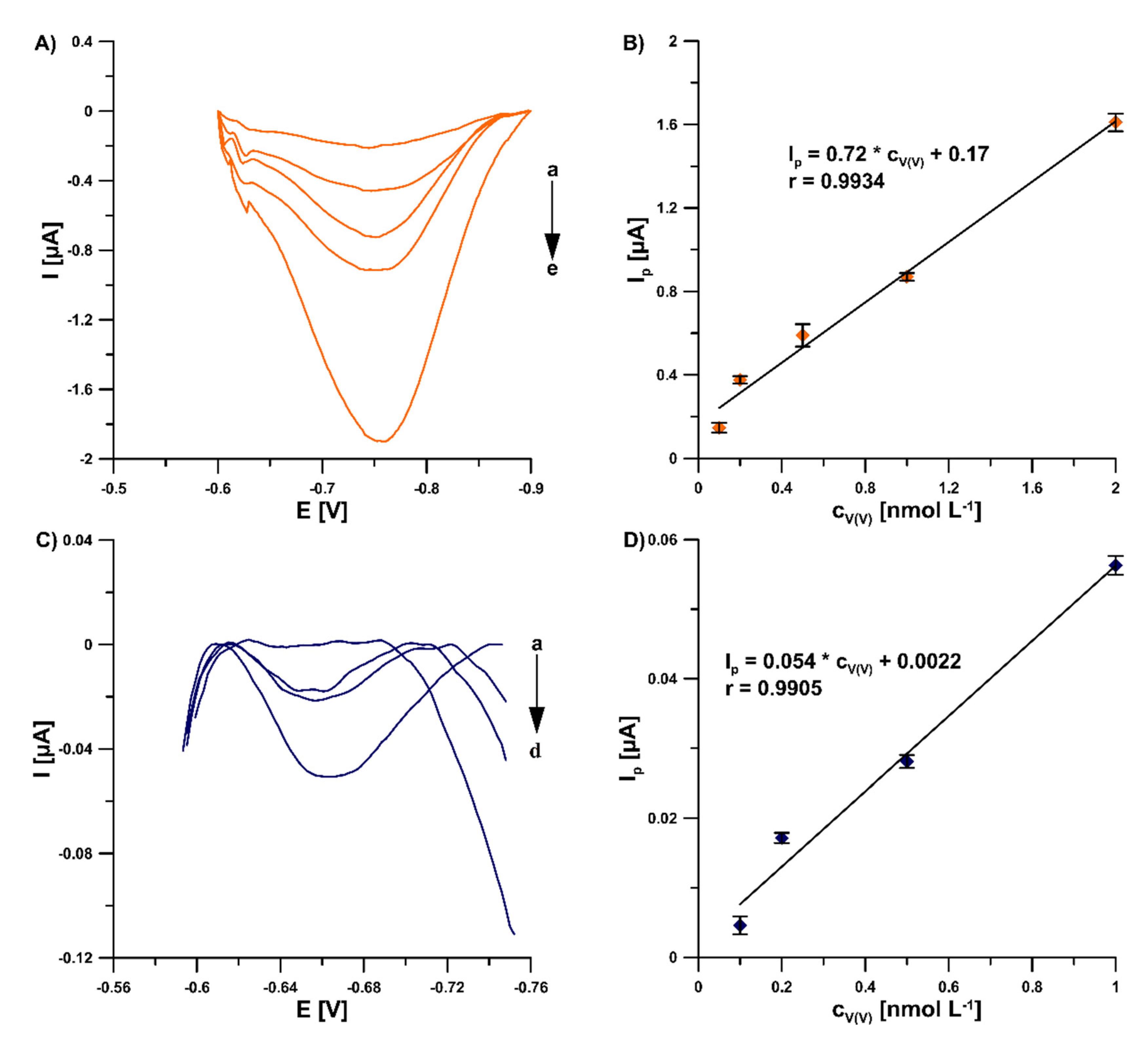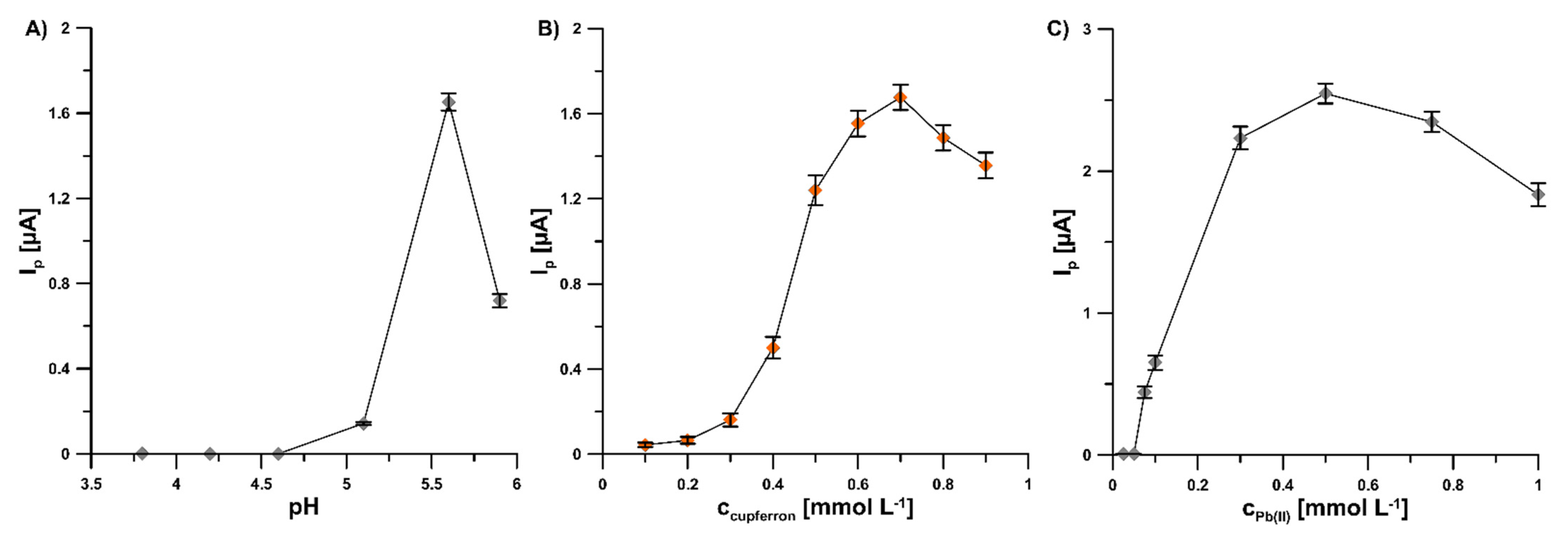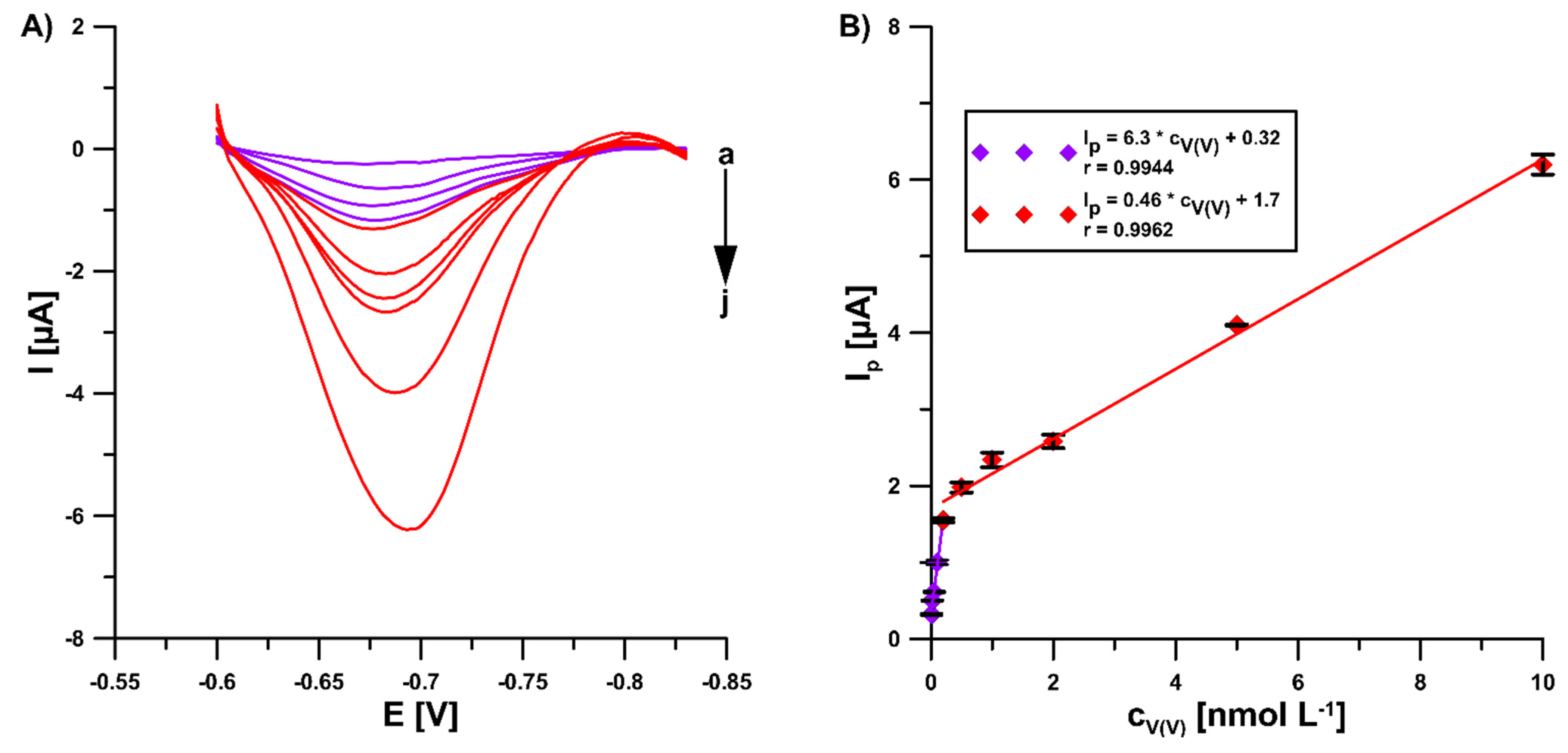Supporting Electrolyte Manipulation for Simple Improvement of the Sensitivity of Trace Vanadium(V) Determination at a Lead-Coated Glassy Carbon Electrode
Abstract
1. Introduction
2. Materials and Methods
2.1. Reagents
2.2. Apparatus
2.3. DPAdSV Procedure Parameters
3. Results and Discussion
3.1. Selection of Supporting Electrolyte and Complexing Agent
3.2. Step of the Optimization Procedure
3.3. Electrochemical Characteristics of the Sensor
3.4. Calibration Graph, Repeatability, and Reproducibility
3.5. Selectivity Studies
3.6. Samples Analysis
4. Conclusions
Author Contributions
Funding
Institutional Review Board Statement
Informed Consent Statement
Data Availability Statement
Conflicts of Interest
References
- Pyrzyńska, K.; Wierzbicki, T. Determination of vanadium species in environmental samples. Talanta 2004, 64, 823–829. [Google Scholar] [CrossRef] [PubMed]
- Jamaluddin, M.; Banoo, A.S. Spectrophotometric method for determination of vanadium and its application to industrial, environmental, biological and soil samples. Talanta 1999, 48, 1085–1094. [Google Scholar]
- Sugiyama, M.; Tamada, T.; Hori, T. Liquid chromatography—catalytic analysis detection for highly sensitive and automated fractional determination of vanadium(IV) and -(V). Anal. Chim. Acta 2001, 431, 141–148. [Google Scholar] [CrossRef]
- Peng, J.; Liu, S.; Deng, C. Separation and determination of trace amounts of aluminium(III), vanadium(V), iron(III), copper(II) and nickel(II) with CALKS and PAR by RP-HPLC. Anal. Sci. 2005, 21, 259–262. [Google Scholar] [CrossRef] [PubMed]
- Li, G.; Wei, Q.; Hu, Q.; Huang, Z.; Yang, G. Simultaneous determination of vanadium, niobium and tantalum by high-performance liquid chromatography equipped with on-line enrichment using 2-[2-(5-bromoquinolinylazo)]-5-diethylaminophenol as pre-column derivatization reagent. Microchim. Acta 2007, 158, 95–102. [Google Scholar] [CrossRef]
- Aureli, F.; Ciardullo, S.; Pagano, M.; Raggi, A.; Cubadda, F. Speciation of vanadium(iv) and (v) in mineralwater by anion exchange liquid chromatography-inductively coupled plasma mass spectrometry after EDTA complexation. J. Anal. At. Spectrom. 2008, 23, 1009–1016. [Google Scholar] [CrossRef]
- Hermann, J.; Axente, E.; Pelascini, F.; Cracium, V. Analysis of multi-elemental thin films via calibration-free laser-induced breakdown spectroscopy. Anal. Chem. 2019, 91, 2544–2550. [Google Scholar] [CrossRef]
- Qureshi, M.S.; bin Mohd Yusoff, A.R.; Shah, A.; Nafady, A. A new sensitive electrochemical method for the determination of vanadium(IV) and vanadium(V) in Benfield sample. Talanta 2015, 132, 541–547. [Google Scholar] [CrossRef]
- He, W.-Y.; Wang, K.-P.; Yang, J.-Y. Spectrophotometric methods for determination of vanadium: A review. Toxicol. Environ. Chem. 2018, 100, 20–31. [Google Scholar] [CrossRef]
- de Souza, V.S.; Teixeira, L.S.G.; Sthefane, J.; Lima, S.O.; da Mata Cerqueira, U.M.F.; de Oliveira, O.M.C.; de Souza Queiroz, A.F.; Bezerra, M.A. Analytical strategies for spectrometric determination of vanadium in samples of interest in the petroleum industry. Appl. Spectrosc. Rev. 2020, 55, 128–157. [Google Scholar] [CrossRef]
- Sander, S. Simultaneous adsorptive stripping voltammetric determination of molybdenum(VI), uranium(VI), vanadium(V), and antimony(III). Anal. Chim. Acta 1999, 394, 81–89. [Google Scholar] [CrossRef]
- Wang, J.; Lua, D.; Thongngamdeea, S.; Lin, Y.; Sadik, O.A. Catalytic adsorptive stripping voltammetric measurements of trace vanadium at bismuth film electrodes. Talanta 2006, 69, 914–917. [Google Scholar] [CrossRef] [PubMed]
- Bobrowski, A.; Nowak, K.; Zarebski, J. Novel voltammetric methods for vanadium determination by exploitation of catalyticadsorptive vanadium–chloranilic acid–bromate system. Anal. Chim. Acta 2005, 543, 150–155. [Google Scholar] [CrossRef]
- Piech, R.; Ba´s, B.; Paczosa-Bator, B.; Kubiak, W.W. Adsorptive stripping voltammetric determination of vanadium(V) witchchloranilic acid using cyclic renewable mercury film silver based electrode. J. Electroanal. Chem. 2009, 633, 333–338. [Google Scholar] [CrossRef]
- Grabarczyk, M.; Adamczyk, M. Application of Electrochemical Sensor Based on Lead Film Electrode in Trace Vanadium (V) Determination by Adsorptive Stripping Voltammetry. IEEE Sens. J. 2019, 19, 5916–5922. [Google Scholar] [CrossRef]
- Grabarczyk, M.; Adamczyk, M.; Wlazlowska, E. The Use of a Solid Bismuth Microelectrode for Vanadium Quantification by Adsorptive Stripping Voltammetry in Environmental Water Samples. Molecules 2022, 27, 2169. [Google Scholar] [CrossRef]
- Dansby-Sparks, R.; Chambers, J.Q.; Xue, Z.-L. Trace vanadium analysis by catalytic adsorptive stripping voltammetry using mercury-coated micro-wire and polystyrene-coated bismuth film electrodes. Anal. Chim. Acta 2009, 643, 19–25. [Google Scholar] [CrossRef][Green Version]
- Li, Y.-H.; Wang, Y.-X.; Huang, M.-H. Determination of Trace Vanadium by Adsorptive Stripping Voltammetry at a Carbon Paste Electrode. Electroanalysis 2008, 20, 1440–1444. [Google Scholar] [CrossRef]
- Deng, P.-H.; Fei, J.-J.; Feng, Y.-L. Determination of trace vanadium(V) by adsorptive anodic stripping voltammetry on an acetylene black paste electrode in the presence of alizarin violet. J. Electroanal. Chem. 2010, 648, 85–91. [Google Scholar] [CrossRef]
- Povar, I.; Cazac, T.; Chiriac, L.; Sandulescu, R. Catalytic-adsorptive determination of vanadium in solutions of 2,3-dihydroxybenzaldehide and bromate ions. J. Electroanal. Chem. 2011, 661, 275–279. [Google Scholar] [CrossRef]
- Rojas-Romo, C.; Arancibia, V.; Moreno-da Costa, D.; Tapia, R.A. Highly sensitive determination of vanadium (V) by catalyticadsorptive stripping voltammetry. Substituent effect on sensitivity III. Sens. Actuat. B-Chem. 2016, 224, 772–779. [Google Scholar] [CrossRef]
- Tyszczuk-Rotko, K.; Jędruchniewicz, K. Ultrasensitive Sensor for Uranium Monitoring in Water Ecosystems. J. Electrochem. Soc. 2019, 166, B837–B844. [Google Scholar] [CrossRef]
- Jędruchniewicz, K.; Tyszczuk-Rotko, K. A new modified scree-printed sensor for monitoring of ultratrace concentrations of Mo(VI). J. Electroanal. Chem. 2019, 847, 113228. [Google Scholar] [CrossRef]
- Tyszczuk-Rotko, K. Metal film electrodes prepared with a reversibly deposited mediator in voltammetric analysis of metal ions. Curr. Opin. Electrochem. 2019, 17, 128–133. [Google Scholar] [CrossRef]
- Mocak, J.; Bond, A.M.; Mitchell, S.; Scollary, G. A statistical overview of standard (IUPAC and ACS) and new procedures for determining the limits of detection and quantification: Application to voltammetric and stripping techniques. Pure Appl. Chem. 1997, 69, 297–328. [Google Scholar] [CrossRef]
- Grabarczyk, M.; Koper, A. How to determine uranium faster and cheaper by adsorptive stripping voltammetry in water samples containing surface active compounds. Electroanalysis 2011, 23, 1442–1446. [Google Scholar] [CrossRef]






| Procedure Step | Parameters |
|---|---|
| Electrochemical cleaning step Lead film deposition | −1.1 V for 15 s and 0.2 V for 15 s −1.1 V (Edep. Pb) for 15 s (tdep. Pb) |
| V(V)–cupferron accumulation | −0.6 V (Eacc.) for 15 s (tacc.) |
| Signal registration | from −0.6 to −0.9 V |
| scan rate of 20 mV s−1 (ν) | |
| amplitude of 100 mV (ΔEA) modulation time of 2 ms (tm) |
| Electrode | Complexing Agent | Linear Range [mol L−1] /Accumulation Time [s] | LOD [mol L−1] | Application | Ref. |
|---|---|---|---|---|---|
| HMDE | chloranilic acid | 4.9 × 10−8–2.9 × 10−7/15 | 2.7 × 10−9 | CRM, see, local portable water, sewage sample | [11] |
| BiFE | chloranilic acid | 9.8 × 10−8–5.0 × 10−7/600 | 3.9 × 10−9 | groundwater | [12] |
| HMDE | chloranilic acid | 2.0 × 10−10–5.0 × 10−8/100 | 9.0 × 10−12 | CRM | [13] |
| Hg(Ag)FE | chloranilic acid | 2.5 × 10−10–1.0 × 10−7/90 | 1.0 × 10−11 | CRM, tap water | [14] |
| PbFE | cupferron | 1.0 × 10−9–7.0 × 10−8/30 | 3.2 × 10−10 | CRM, river water | [15] |
| BiFµE | cupferron | 8.0 × 10−10–1.0 × 10−7/60 | 2.5 × 10−10 | CRM, river, rain, and tap water | [16] |
| MWE | gallic acid | 1.0 × 10−10–2.0 × 10−8/120 | 1.7 × 10−11 | river water | [17] |
| Polystyrene-coated BiFE | gallic acid | 2.0 × 10−9–2.0 × 10−8/600 | - | - | [17] |
| CPE | alizarin red S | 2.0 × 10−9–3.0 × 10−7/120 | 7.8 × 10−10 | tap, river, and groundwater | [18] |
| ABPE | alizarin violet | 8.0 × 10−10–1.0 × 10−7/90 | 6.0 × 10−10 | tap, river, and mineral water | [19] |
| SME | 2,3-dihydroxybenzaldehide | 5.0 × 10−10–5.0 × 10−8 / 30 | 6.0 × 10−10 | river water | [20] |
| HMDE | QSA | No data–7.0 × 10−9/30 | 4.5 × 10−12 | tap, purified drinking, river, and commercial water for chromatography | [21] |
| GCE/PbF | cupperon | 1.0 × 10−11–2.0 × 10−10/15 2.0 × 10−10–2.0 × 10−8 | 2.8 × 10−12 | CRM river water | This work |
| Sample | Measured Value ± SD (n = 3) [mol L−1] | Certified Value ± SD (n = 3) [mol L−1] | Recovery [%] | Relative Error [%] |
| CRM | ||||
| (estuarine water) | 4.96 × 10−8 ± 0.51 | 5.05 × 10−8 ± 0.609 | 98.2 | 1.8 |
| Sample | Added [mol L−1] | Found± SD (n = 3) [mol L−1] | Recovery [%] | Relative Error [%] |
| Vistula | 0 | 4.7 × 10−9 ± 0.24 | - | - |
| River | 5.0 × 10−9 | 10.2 × 10−9 ± 0.52 | 105.2 | 5.2 |
| 10.0 × 10−9 | 14.5 × 10−9 ± 0.69 | 98.6 | 1.4 |
Publisher’s Note: MDPI stays neutral with regard to jurisdictional claims in published maps and institutional affiliations. |
© 2022 by the authors. Licensee MDPI, Basel, Switzerland. This article is an open access article distributed under the terms and conditions of the Creative Commons Attribution (CC BY) license (https://creativecommons.org/licenses/by/4.0/).
Share and Cite
Tyszczuk-Rotko, K.; Gorylewski, D.; Kozak, J. Supporting Electrolyte Manipulation for Simple Improvement of the Sensitivity of Trace Vanadium(V) Determination at a Lead-Coated Glassy Carbon Electrode. Sensors 2022, 22, 8209. https://doi.org/10.3390/s22218209
Tyszczuk-Rotko K, Gorylewski D, Kozak J. Supporting Electrolyte Manipulation for Simple Improvement of the Sensitivity of Trace Vanadium(V) Determination at a Lead-Coated Glassy Carbon Electrode. Sensors. 2022; 22(21):8209. https://doi.org/10.3390/s22218209
Chicago/Turabian StyleTyszczuk-Rotko, Katarzyna, Damian Gorylewski, and Jędrzej Kozak. 2022. "Supporting Electrolyte Manipulation for Simple Improvement of the Sensitivity of Trace Vanadium(V) Determination at a Lead-Coated Glassy Carbon Electrode" Sensors 22, no. 21: 8209. https://doi.org/10.3390/s22218209
APA StyleTyszczuk-Rotko, K., Gorylewski, D., & Kozak, J. (2022). Supporting Electrolyte Manipulation for Simple Improvement of the Sensitivity of Trace Vanadium(V) Determination at a Lead-Coated Glassy Carbon Electrode. Sensors, 22(21), 8209. https://doi.org/10.3390/s22218209






